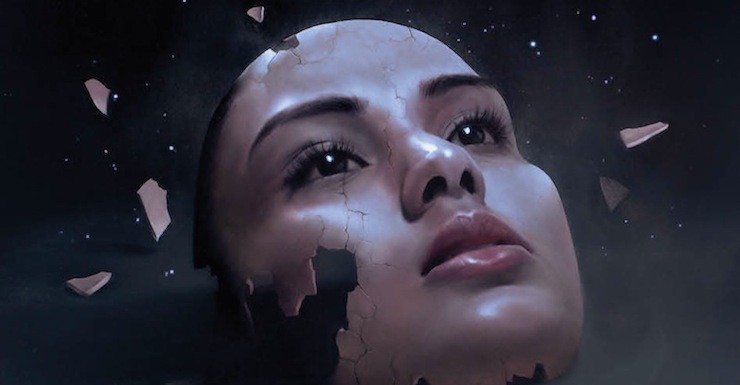While they fall on somewhat different points of the morality spectrum, both the Imperial Radch and the Empire of Masks share the same goal: to colonize other alien (whether foreign lands or planets) cultures and convert these peoples into ideal citizens. Here, “ideal” doesn’t necessarily mean “right,” it means one who embodies the culture: uniformity among the many conquered peoples, with clearly-defined codes of conduct, and an aesthetic that sums up the society’s core values. It also comes at the expense of the varied cultures over which they steamroll, condemning and erasing diverse identities.
It’s horrifying and engrossing, and keeps us reading despite the revulsion that bubbles up. But what most keeps us engaged in Ann Leckie’s Ancillary Justice and Seth Dickinson’s The Traitor Baru Cormorant is the fact that both series’ protagonists—Justice of Toren One Esk, a.k.a. Breq, and Baru Cormorant—have personal vendettas against their systems while they’re in the process of trying to destroy them from the inside. Yet for all their rebellion, they are both on their way to becoming ideal citizens themselves.
Spoilers for Ancillary Justice, minor spoilers for Ancillary Sword and The Traitor Baru Cormorant.
When it comes to crafting ideal citizens, suppression, conditioning, and assimilation are the names of the game.
The cycle has to end, the Falcresti handbook says about the tenuous structures of civilization in constant threat of collapse. The civilization game can be solved. Together we propose a solution. Medical advancements and the promise of better education, brought from the Empire of Masks to Baru’s home island of Taranoke, initially seems positive. But those invading ships also bring a plague in their wake, which wipes out much of the population. Those who are left are subjected to what can only be called indoctrination, with all “unhygienic” behavior forcibly pressed out of them with proofs and qualms and other Incrastic mantras. Such new doctrines strike Baru personally, as she loses one of her fathers and sees her friend narrowly avoid sexual assault in the form of a “cure” for her supposed queerness.
The Radch’s methods of colonization are a gray-area mix of brutal integration and cultural advances, as this post on the politics of the Imperial Radch lays out in greater detail. In short: The Radchaai are civilized, and everyone outside of their provinces are not. Their M.O. is to swoop in, kill as many people as necessary, then go through a stage of annexation, during which they execute leaders and potential rebels. (But they’re OK with integrating local religions and the like!) Many of the conquered peoples are frozen, to be used in the future as “ancillaries,” or corpse soldiers, while the rest become Radchaai in dress, behavior, and culture (more on that later). In her original form, Justice of Toren One Esk oversaw annexations like these and didn’t question the Radchaai’s methods.

In the Empire of Masks, conditioning is a part of early life, a consistent, unceasing way to subtly mold all manner of different people into one ideal. Snitching on fellow citizens for not following Incrastic ideals is encouraged; then there are the conditioning cells, which use pleasant and decidedly unpleasant stimuli to cement certain associations:
In another conditioning cell, a man sat in a drugged stupor, manacled to a chair, moaning in chemical bliss, while a functionary in a bone-white mask stared into his eyes and recited: “Falcrest. Mask. Hygiene. Incrastic. Loyalty. Compliance.”
A crash of hidden symbols. The functionary raised a smoking censer to the man’s face, poison-yellow, as the crash came again, again, again. “Rebellion,” the mask said, as the man began to shriek. “Revolt. Devena. Himu. Wydd—”
In extreme cases, Falcrest breeds the Clarified, “instrument[s] conditioned from birth by drug and bell,” who react like puppets under certain keywords. More than that, they delight in serving their sole purpose. When Baru meets her Clarified bodyguard (of sorts) Purity Cartone, she is thrilled and then immediately sickened by the realization that she can control him totally.
Yet Baru acknowledges that she herself is the product of Masquerade conditioning: shame at the Taranoke ways of her childhood, the neverending self-governance that keeps her emotionally distant from potential allies like Tain Hu and her secretary and advisor Muire Lo.
The Radchaai call it “reeducation” instead of “conditioning,” though they’re loathe to discuss the distasteful subject much at all. In Ancillary Sword, Breq is intrigued by Sirix Odela, a Samirend-turned-Radchaai citizen on Athoek Station who must visibly restrain herself from getting too angry, or else she will be physically discomfited. Breq confronts her: “Reeducation usually works by straightforward conditioning, by making it intensely unpleasant to do the thing that got you arrested to begin with”—intentionally prodding at whatever minor rebellion Sirix committed, which the Radch used to make an example out of her.
While conditioning gets its claws into your very circuitry, citizens must also resemble one another on a surface level, and both the Empire of Masks and the Imperial Radch require certain signifying markers from their ideal citizens—namely, literal gloves and figurative masks.
In neither book is it explicitly explained what the deal with gloves is, simply that it is a Thing That Must Be Done. However, in a 2014 Reddit AMA, Leckie did shed some light on the Radchaai quirk, comparing gloves to underwear or pants and explaining that Radchaai are “taught from small that hands are dirty and it’s just decent to cover them in public.” The same propriety seems to exist with the wearing of gloves in the Empire of Masks, to the point that they are a casualty of fights where blood is drawn or mapping out skirmishes in dirt or charcoal. I couldn’t help but read both examples as the old adage of not wanting to get one’s hands dirty.
Tea is also a staple of Radchaai society, so ubiquitous so as to not be even considered a luxury. Why all the conformity? While neither book explicitly explains it, this uniformity would seem to be a way to unite disparate cultures who would have nothing in common and might never have crossed paths were it not for their new overlords. If everyone knows to follow intrinsic rules such as keeping your hands covered, knowing what tea set to use for which rank, and how to rein in your emotions, it puts you on the same page (if not equal footing, as both societies have clear hierarchies). This blog post on Ancillary Justice also posits that conformity creates comfort and decreases ambition, allowing empires to control and choke rebellions.
As for the masks—both instances represent self-preservation, though the stakes are much higher in the Empire of Masks (or, as it’s mockingly called, the Masquerade). Wearing a mask is vital to survival, as Falcresti mentor figure Cairdine Farrier explains to a young Baru:
“Man and woman, rich and poor, Stakhieczi or Oriati or Maia or Falcrest born—in our Imperial Republic you can be what you desire, if you are disciplined in your actions and rigorous in your thoughts. That’s why it’s an Empire of Masks, dear. When you wear a mask, your wits matter.”
Even the Emperor sits on a Faceless Throne, which Baru later discovers is actually run by a group of puppet-masters working under pseudonyms and their own system of checks and balances.
The above quote is ironic, as citizens can be what they desire only so long as it exists within the rigid constraints of the Masquerade. The Empire of Masks taunts its citizens with scenarios like this, by dangling the promise of freedom before them long enough to inspire complacency, before trapping them in their rebellion. Partway through the novel, Duchess Tain Hu tells Baru—in a passage that will recur later—that “in Falcrest prisoners are permitted to escape their cells, permitted to reach the streets, only to be recaptured. Again and again. So that they will learn that escape is always an illusion.”
And when that doesn’t work… well, that’s what the conditioning cells are for.
The Radchaai utilize masks more for daily life than for big conspiracies: Behavior calls for a certain amount of discipline, especially when it comes to interpersonal interactions. Rather than clearly broadcast emotions, Radchaai are cordial and impassive; they’re more comfortable expressing misgivings or other emotional responses through subtle finger twitches to whichever AI they’re in constant, near-telepathic communication with. Breq experiences both sides of this, having been tapped into her beloved Lieutenant Awn when she was Justice of Toren, and later as a captain with her own odd tie to a ship. Ancillaries of course are the best at this impassivity, being extensions of AI, but human Radchaai also attempt to emulate that same absence of emotion. Of course, everything underneath the mask betrays them: Their chemical and hormonal levels are laid bare to an AI, whether it’s a ship like Justice of Toren monitoring its crew or Station checking in on its inhabitants.
At first consideration, neither Breq nor Baru would seem like an ideal citizen for either empire: One is a splintered ship living in a human body; a quirky AI at her best, Breq now struggles to pass as not only a human, but a Radchaai-civilized one. Then you have a queer woman with fierce, near-unbreakable ties to her family on an island that no longer exists. Though she purports to be a master compartmentalizer, Baru can’t forget the family she left behind, and her promise to return to them one day.
Yet what neither realizes is that the experiences and characteristics that allow each to infiltrate her respective culture in the hopes of breaking it apart establishes how much the culture itself has already formed her into its particular ideal.
When Justice of Toren is destroyed, what is left is Breq, a single body that can barely contain all of One Esk’s memories and impulses. What’s more, Breq’s body is Ghaonish and immediately reads as foreign to the Radchaai, so she must redouble her efforts to fit in. She must unlearn ingrained ship programming and replace it with the minute behavioral and performative details that humans take for granted. Over the course of nineteen years, Breq must reteach herself human mannerisms and Radchaai culture, re-forming herself from shards into a mostly cohesive person.

While Breq is still very disjointed, we discover in Ancillary Justice that One Esk was not the first Radchaai entity to split apart: The empire’s ruler Anaander Mianaai, long known to split herself into countless bodies, has begun to turn against herself. Mianaai’s reasoning for her ancillaries is not unlike any of the ships: So she can be everywhere. But just as One Esk began subtly fragmenting even before it lost its hive mind, Mianaai’s segments began developing their own individual thoughts and feelings based on where they were in the universe as well as the destruction of the planet of Garsedd—an act that was not only polarizing to Radchaai citizens, but to Mianaai herself.
In Ancillary Sword, Breq (now promoted to fleet captain) gets saddled with Lieutenant Tisarwat, a lilac-eyed upstart who has been brutally transformed (via surgical implants) into an ancillary for Mianaai. Even though Breq forcibly breaks the connection, Tisarwat is left in the same strange, fragmented state One Esk found herself two decades prior. Considering that much of the Radchaai culture is based on (a) operating artificial or organic intelligence through multiple bodies and (b) even singular bodies being hooked up to an AI monitoring them, it would appear that characters like Breq, Mianaai, and Tisarwat are the new normal.

Just as Breq must teach herself Radchaai customs and behavior, Baru Cormorant learns from an early age to hide her two greatest secrets: She is queer, and she is a traitor to the Empire of Masks. Rather than openly revolt against the erasure of Taranoke and the loss of her father Salm, Baru swallows her hate and decides that her best course of action is total immersion. Yet for all of her wits, Baru is still human; still has moments of weakness, as she is drawn to the fierce duchess (and her tentative ally) Tain Hu, as she puts her own haste to restore Taranoke to its former glory in the way of the patience it requires to break the Traitor’s Qualm—that is, to marshal enough support to her rebellion without forcing the dukes and duchesses of Aurdwynn into siding with the Empire of Masks. Her quick mind is filled with constantly moving pieces, and she is constantly aware of the vulnerable spots she leaves open to Cairdine Farrier and his cohorts, who are watching her every move from Falcrest.
During Baru’s childhood, Cairdine Farrier tells her the story that the Falcresti public believes about their Emperor: That once every five years, the government chooses a normal man to be Emperor, and gives him a draught of amnesia that takes away his identity:
“Behind the Emperor’s Mask, he would be unrecognizable; and behind the fog of that potion, he would not recognize himself. He would retain his knowledge of the world, its history and geography, its policies and pressures. But he would have no idea who he had been before he was Emperor.”
Both Baru and Farrier know that this is just a story, a way to soothe the mob. Because behind the mask, you always know who you are, and what exactly you’re hiding. No one needs the mask as desperately as Baru does.
The only way that Breq and Baru’s transformations could be at all positive would be if they succeed in their quests; so far, we’ve seen only the sacrifices they’ve made and the lives lost and destroyed in the process. And what neither realizes is that, as the person responsible (assuming it works) in breaking her system, she will also be forced to have a hand in re-molding it into something better, and deciding who the next generation of ideal citizens will be.
The Traitor Baru Cormorant is available September 15 in the U.S. and UK (as The Traitor) from Tor Books. Read excerpts on Tor.com!
Ancillary Mercy is available October 6 from Orbit.
Natalie Zutter wasn’t sure she really got either of these books when she started reading them, but they’ve gotten her thinking more than most of the books she’s read this year. You can read more of her work on Twitter and elsewhere.










